Summer blockbuster season is in full swing. For many moviegoers, that means escaping to a galaxy far, far away—or perhaps just a different version of our own planet Earth—through science fiction and fantasy movies. As fans clamor for the latest cinematic thrills, we decided to focus our next Diversity Gap study on the level of racial and gender representation in these ever-popular genres that consistently rake in the big bucks for movie studios. We reviewed the top 100 domestic grossing sci-fi and fantasy films as reported by Box Office Mojo. The results were staggeringly disappointing, if not surprising in light of our past Diversity Gap studies of the Tony Awards, the Emmy Awards, the children’s book industry, The New York Times Top 10 Bestseller List, US politics, and the Academy Awards, where we analyzed multi-year samplings and found a disturbingly consistent lack of diversity.
Among the top 100 domestic grossing films through 2014:
• only 8% of films star a protagonist of color
• of the 8 protagonists of color, all are men; 6 are played by Will Smith and 1 is a cartoon character (Aladdin)
• 0% of protagonists are women of color
• 0% of protagonists are LGBTQ
• 1% of protagonists are people with a disability
The following interviews with two prominent entertainment equality advocacy groups shed more light on the subject.

Marissa Lee is co-founder of Racebending.com, an international grassroots organization of media consumers who support entertainment equality. Racebending.com advocates for underrepresented groups in entertainment media and is dedicated to furthering equal opportunities in Hollywood and beyond.
Imran Siddiquee is Director of Communications at the Representation Project, which is a movement that uses film and media content to expose injustices created by gender stereotypes and to shift people’s consciousness toward change. The Representation project was the follow-up to the critically acclaimed documentary Miss Representation.
Jason Low: Do these statistics surprise you? Why or why not?
Marissa Lee: The statistics are certainly striking, especially since sci-fi and fantasy belong to a genre that prides itself on creativity and imagination. These statistics aren’t necessarily surprising, since lack of diversity in Hollywood films is a well-known problem. There have been enough studies and articles, and any moviegoer can pause to notice there is a disparity. . . . Hollywood can’t go on pretending that this isn’t a problem.
JL: Do you think the American movie-going audience would support a big, blockbuster sci-fi/fantasy movie with a diverse protagonist if a studio made it?
Imran Siddiquee: Yes, definitely. But I think an important thing to understand about Hollywood blockbusters is that they are almost never flukes; they are preordained. Sure, we have the occasional surprise indie hit, but you need a lot of money and marketing behind you to become a blockbuster. Just look at the top ten films in each of the last five years: nearly every single one had a budget of more than $100 million (a lot of them were also sci-fi/fantasy films).
Meanwhile, there hasn’t been a single film released this year starring a person of color with a budget of more than $50 million, let alone a sci-fi film, which is naturally going to be more expensive. The same goes for most of the last decade. So for anyone who might say “people just don’t watch sci-fi movies starring people of color,” or “there’s no evidence that this would work,” the truth is that we have no evidence that it wouldn’t work.
Studios take a couple of massively expensive chances every year on mostly unknown actors or directors—aka giving the Spider-Man franchise to Marc Webb and Andrew Garfield in 2012—but they just don’t take those kinds of chances on people of color. In other words, if Hollywood wanted to make a blockbuster sci-fi/fantasy film starring a woman of color, they definitely could.
ML: I think American audiences would support a film with a diverse protagonist, because we already have. One pullout statistic from your infographic is that Will Smith leads six of the top 100 big sci-fi/fantasy films. His race wasn’t a huge impediment to box office success and may have, in fact, been part of what made him all-American and relatable. That was back in the late 1990s, but since then, Hollywood hasn’t tried to find a new Will Smith. This is kind of ironic, given that Hollywood likes to stick to formulas and sequels! They could push forward another actor—or actress—of color with Smith’s charisma. They haven’t.
The American movie audience supports any movie that Hollywood successfully markets well, especially—but not always—if the film is well produced. Hollywood has managed to market some weird stuff, like a tentpole movie about talking teenage turtle martial artists, or cars that change into space robots, and so on. I don’t buy that when it comes to marketing diverse leads, suddenly this giant industry can’t do it.
 I’d be interested in seeing how many of these top 100 grossing sci-fi and fantasy films star non-human leads. I wonder if there are more films with non-human leads than minority human leads on the list!
I’d be interested in seeing how many of these top 100 grossing sci-fi and fantasy films star non-human leads. I wonder if there are more films with non-human leads than minority human leads on the list!
(Side note: Does the infographic count Keanu Reeves as white or as a person of color? I think he has more than one movie on this list given The Matrix trilogy…)
Editorial note: Yes, Keanu Reeves is counted as a PoC and did make the list for The Matrix. The second Matrix film, The Matrix Reloaded was the only installment of the trilogy to make the top 100 list.
JL: What challenges have you faced or seen peers facing as a woman/person of color, etc.?
ML: There are films with built-in audiences that Hollywood still insists on whitewashing, which has a very adverse effect on actors of color. Let’s be honest, audiences would have still flocked to see The Hunger Games or Twilight if characters like Katniss or Jacob had been cast with people of color as they were written in the books. An actor with a disability could have played the protagonist in Avatar—if we have the technology and imagination to animate a fanciful world populated by blue cat people, we could have cast an actor with a disability similar to the lead character’s in that role. As a result of these casting decisions, up and coming actors from underrepresented groups were deprived of career exposure from being a part of these established franchises, making it harder for Hollywood ever to try and launch a new franchise with an actor from an underrepresented group.
Every single Marvel Studios movie has centered around a presumably straight, white, male protagonist, even if white women (mostly love interests) and men of color (support roles) have played roles in the film. The franchise is a box office juggernaut and has a ton of movies on this list, but we’ve gotten two to three movies about each of the men on the Avengers and there’s yet to be a film about Black Widow. Both of Marvel’s ensemble films—The Avengers and Guardians of the Galaxy—trimmed down the superhero teams for their film adaptations, and the women characters, save for one, were the first to be cut. Most moviegoers will never know that women of color and LGBTQ characters were cut from Guardians of the Galaxy, but audiences will get to relate to the talking raccoon and the talking tree.
More recently, the Divergent franchise cast Naomi Watts to play a character who was a woman of color in the books. It’s a supporting role for an already established franchise, and for whatever reason the production still couldn’t bring themselves to cast an actor of color.
Trends that fans have noted in the media include that in big blockbuster sci-fi and fantasy films, the presence of a straight, white, able-bodied, cis male in some central role in the story is almost guaranteed, while the presence of characters with “minority” identities (e.g. LGBTQ folks, people of color, people with disabilities, women, etc.) is not. Even when a character who isn’t a straight, white cis male is centered in a story, there’s probably a straight, white, cis male character playing second, if not lead, billing. For example, while we can reasonably assume that the next few Star Trek and Star Wars movies will have some diverse characters, we can guarantee that at least one of the leads will be a straight, white man. If The Hunger Games or Twilight had cast actors of color for Katniss or Jacob, there would still have been plenty of lead roles filled by white actors. DC is including Wonder Woman in an upcoming movie, but the film will also feature Batman and Superman.
This means that someone with a lot of intersecting privileged identities (especially straight, white men) will always be able to walk into a multiplex and find a sci-fi/fantasy movie starring someone who shares those identities. If you have a lot of marginalized identities, then representation is a sometimes thing, never a solid guarantee. There is a very small but vocal minority of people who want to maintain this status quo, and Hollywood seems to cater toward them due to institutionalized racism, fear, and habits. But there are just as many, if not more, people who are willing to support, vociferously, films with diverse leads. I wish our money was as good as theirs.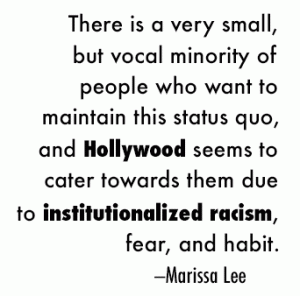
JL: How can consumers encourage more diversity in movies?
IS: Avoid buying tickets to films which clearly rely on stereotypes or demeaning portrayals of people based on gender, race, class, age, sexual orientation, ability, or circumstance. And anytime you do watch a film, give it The Representation Test afterward. The test grades films on their inclusiveness pertaining to all those above categories. When a movie scores really low on the test, use #NotBuyingIt on Twitter to let the filmmakers and all your friends know how you feel. Since so much of this industry is based on money, this is one way we can express our discontent and get the attention of the studios.
ML: Media literacy is a huge start. As media consumers, we should feel empowered to critique the media we consume, and to decide what media we choose to consume. Beyond helpful steps like going to see movies that feature diverse leads, it’s just as important to start conversations in our own communities and with our friends and family (the people we consume media with!) to raise awareness about diversity and representation. Even if we don’t go to see movies that whitewash or exclude or present discriminatory content, people we know will. One way we can help change things is by continuing to start conversations. We need to create an environment where it is safe to criticize popular franchises for lacking diversity. We also need to keep drowning out the malcontents who cannot even handle actors of diverse backgrounds in supporting roles. Social media has really knocked down barriers when it comes to communicating our opinions with Hollywood brass. It’s also given us several spaces where we can discuss the media we consume with our friends and family. In addition, the internet has really changed how we access and consume media. There are Kickstarters and indie channels and online comics and other outlets so we don’t have to be reliant on big production studios or publishers as our only sources of entertainment.
JL: How close or far do you think we are from getting these statistics to change?
IS: When you’re talking about representation that is this low, it’s hard to go anywhere but up. For instance, 0% for women of color in top sci-fi films means I’m being honest when I say things will certainly improve soon, but that’s not saying much. I think we are pretty far away from true equality, or a cinema that reflects and includes the broad diversity of human experiences in the real world.
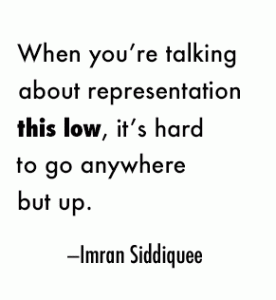 Too many wealthy, white men still run Hollywood, and their decisions still have too much power. As I mentioned earlier, these kinds of movies are very expensive, and so it’s hard for independent or upstart filmmakers to break through or compete.
Too many wealthy, white men still run Hollywood, and their decisions still have too much power. As I mentioned earlier, these kinds of movies are very expensive, and so it’s hard for independent or upstart filmmakers to break through or compete.
That being said, the slight increase in success for white women in blockbuster sci-fi movies, such as Gravity, The Hunger Games, and Divergent, means change is possible. And it’s hard to overstate the importance of the Oscar wins for 12 Years a Slave last year, because while it wasn’t a blockbuster, it is a film that everyone in the industry now knows about and has probably seen. And the whole reason we’re even talking about representation in movies right now is because we know how much seeing different experiences on screen can impact people’s real world thoughts and attitudes. So films like 12 Years a Slave are part of the gradual shifting of consciousness that has to happen in Hollywood to get to a point where studios are consistently greenlighting big-budget films starring people of color.
ML: As budgets for tentpole science fiction and fantasy movies have soared, studios have been more reluctant to take a chance on actors or characters that they perceive as risks. Because people of color and women are also already more likely to consume movies than white people and men, maybe they don’t feel an incentive to change what they are doing because, from their perspective, minorities are perfectly willing to watch films starring white guys. Hollywood is pretty stubborn, especially when it comes to tentpole movies. We are seeing more diversity in television, particularly in children’s television, as well as in online content. The establishment will change when someone influential in Hollywood decides to take the risk and make an effort to diversify their film offerings. The stats in this infographic are focused on profit, not art. For things to change, Hollywood needs to believe that diversity can be profitable.
***
This is not an isolated incident, but a wide reaching societal problem.
Read more Diversity Gap studies on:
The Academy Awards
The Tony Awards
The Emmy Awards
The children’s book industry
The New York Times Top 10 Bestseller List
US politics
Further resources on how to teach content and visual literacy using Lee & Low Books’ infographics series on the Diversity Gap:
Using Infographics In The Classroom To Teach Visual Literacy
CONTACT: For more information or to request permission to reprint, please email hehrlich[at]leeandlow[dot]com
Filed under: Diversity, Race, and Representation, Guest Blogger Post, The Diversity Gap Tagged: African/African American Interest, Asian/Asian American, diversity, Latino/Hispanic/Mexican, LGBT, Middle Eastern, Multiracial, Native American, Race issues, Science Fiction/Fantasy, whitewashing



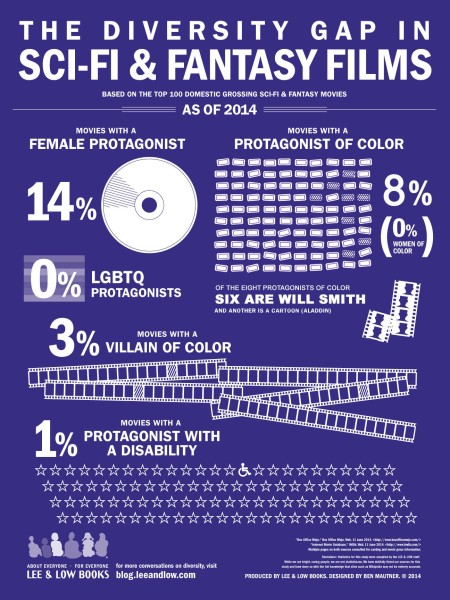

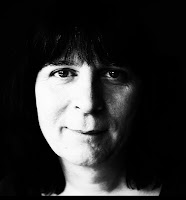
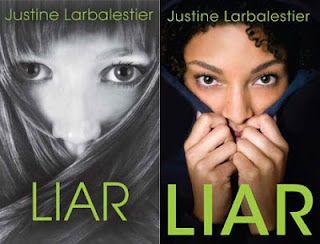



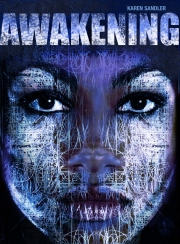

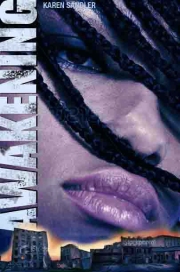
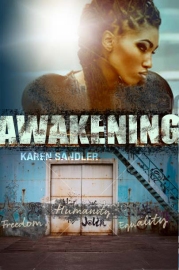














Wow, this is depressing. 6 of 8 are Will Smith… It’s really hard to surprise me with bad diversity news out of Hollywood, but that did.
Great job as usual, Lee and Low team!